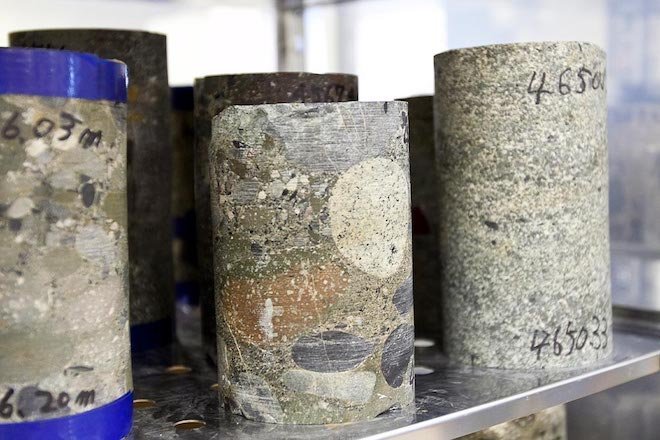Core Analysis
JAPEX Research Center is equipped with the facilities and personnel to provide the testing and analysis required in a wide range of fields, from exploration and development to production and transportation, for providing services both in Japan and abroad.
Please refer to Technical Services page about our technical services, including providing research/analysis items and contact.
Summary of Core Analysis
Oil and natural gas exist mostly in formations called reservoirs several thousand meters underground where they are prone to accumulate. To locate and extract oil/natural gas in reservoirs, we need to drill wells to that depth. A columnar rock sample taken from a well is called a "core."
A core is analyzed to determine the characteristics of the rock. The data derived from the analysis is used for estimating the volume of reserves, formulating development plans, and making projections. To raise the success rate of developing oil/natural gas from a reservoir, it is imperative that samples are taken directly from that reservoir.
Survey/Analysis Items
Core analysis measures/analyzes primarily porosity, which is the ratio of pores or void spaces to the total volume of the core, and permeability, which is the ability for oil/natural gas to flow between pores.
- Measurement of porosity (helium porosimetry)
- Measures the ratio of the volume of pores to the total volume of a core
- Measurement of permeability (air permeametry)
- Measures the permeability of a rock, which is an indicator of the ability for oil/natural gas to flow (flowability) through pores in the rock
- Measurement of porosity & permeability under confining pressure
- Measures the porosity and permeability under overburden (confining) pressure that affects the volume of pores and permeability of reservoirs deep underground
- PDPK (profile permeametry)
- Estimates the distribution of permeability of a rock sample (whole core) in a simple and short manner by sequentially measuring the permeability on its surface
- Measurement of resistivity
- Estimates the ratio of fluids (oil and water) contained in pores of a reservoir rock (saturation) by measuring the resistivity of the rock sample
- Measurement of capillary pressure (centrifuge method)
- Measures the capillary pressure exerted on two types of fluids (oil and gas), which affects the distribution of flowability and saturation in a reservoir, using a centrifuge.
- Measurement of capillary pressure (mercury porosimetry)
- Measures the capillary pressure exerted on rock samples that are too small or brittle to form a core by injecting mercury.
- Measurement of pore size distribution (mercury porosimetry)
- Measures the sizes (diameters) and volume of pores in a rock sample, which affect the rock's properties such as permeability.
- Measurement of threshold pressure
- Estimates the maximum capillary pressure (threshold pressure), at which oil and gas are held by a cap rock (e.g. shale and mudstone).
- Relative permeability (core flooding)
- Estimates the ratio of each of two different types of fluids (e.g. gas & oil, and water & oil) flowing in a reservoir (threshold) and their permeability, in a core flooding test using simulated reservoirs.

Cores actually extracted and analyzed
Our website uses cookies to improve the convenience of our visitors when browsing our site. If you agree with our policy on the use of cookies, please click the "Agree" button. If you do not agree to the use of cookies when browsing our website, please disable the cookie setting in your browser.
